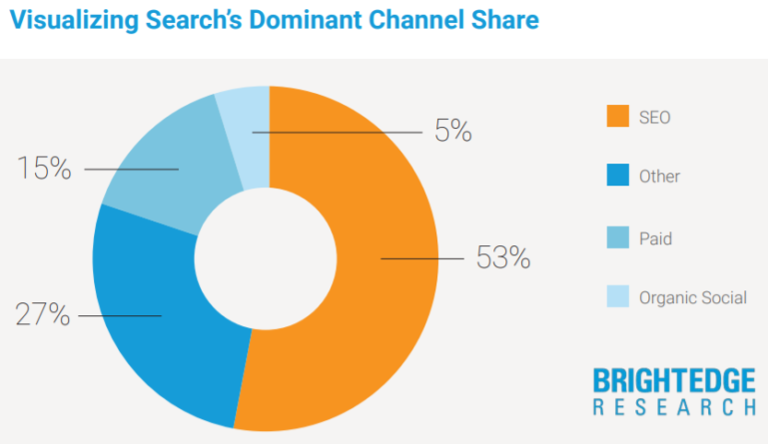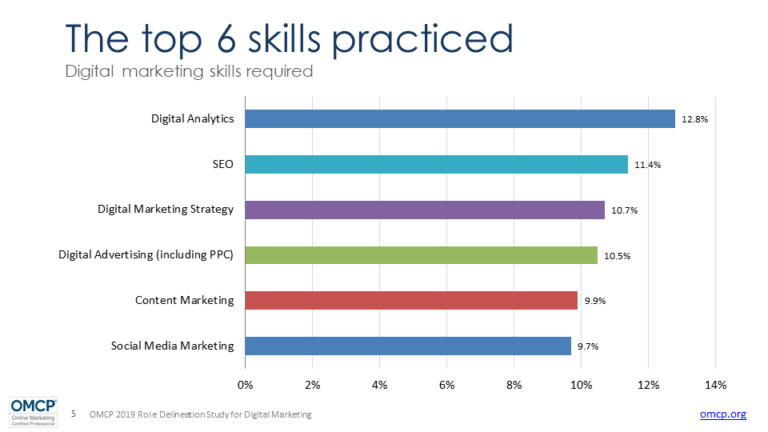A couple of years ago, I was in the supermarket when I overheard half of a phone conversation.
Apparently, someone had called and wanted to talk with the vice president of vegetables.
The employee who took the call replied politely, “Well, we have three vice presidents of vegetables. One is in charge of fresh vegetables, another is in charge of canned vegetables, and the third is in charge of frozen vegetables. So, which one would you like to talk to?”
It’s funny, but it also makes you think: Why are there so few vice presidents of search engine optimization?
If you do a search on Indeed, then you’ll find that there are 5,527 open jobs in the United States for an SEO manager.
And the average salary for an SEO manager is $87,442 per year.
But, you’ll also find that there are currently no open jobs in the U.S. for a VP of SEO.
On the other hand, there are 981 open jobs for a vice president of marketing – and the average salary for a VP of marketing is $171,370 per year.
Umm, OK.
So, why is this worth noting?
The Business Case for a VP of SEO
According to BrightEdge Research, 53% of trackable traffic to the average website comes from organic search.
Now, this share of traffic ranges from:
- 64.1% at B2B sites.
- 59.8% at Technology sites
- 53% at Media & Entertainment sites.
- 41.4% at Travel & Hospitality sites.
- 41% at Retail & Ecommerce sites.

But, no other channel comes close – except direct traffic.
And one of the initial sources of direct traffic is organic search traffic, which then returns to websites at a later date.
In terms of share of revenue, organic search is also the largest trackable channel, with an average 44.6% share.
Again, this share of revenue ranges from:
- 58.8% at Technology sites.
- 52.7% at B2B sites.
- 40.6% at Travel & Hospitality sites.
- 36.4% at Retail & Ecommerce sites.
- 34.7% at Media & Entertainment sites.
And if you look at your top conversion paths in Google Analytics, you’ll likely discover that organic search plays a major role in the initial discovery process when people explore solutions to a need.
Many of these people then use the direct channel after they have a better understanding of the problems, solutions, and providers available.
So, yes, I could make the business case for having at least one VP of SEO at most large organizations.
If organic search generates 53.0% of your website traffic and 44.6% of your revenue, then it is more important to your success than vegetables are to a supermarket.
And for some large enterprises, I could even make the business case for giving three out of five vice presidents at least some SEO responsibilities:
- A VP of Technical SEO who would be in charge of the usability of webpages and preparing for Google’s upcoming Page Experience update.
- A VP of On-Page SEO who would also be in charge of Content Marketing.
- A VP of Off-Page SEO (a.k.a., link building) who would also be in charge of Social Media Marketing.
- A VP of Digital Advertising who would also be in charge of PPC advertising (a.k.a., paid search).
- A VP of Digital Analytics who would also be in charge of Search Console tools and reports.
All of these VPs would report to a chief marketing officer, who would be responsible for digital marketing strategy.
Would This Require a Reorg?
For the vast majority of large enterprises, it would.
But, such an organizational structure would reflect the current practice ratios as well as skill, education, and experience requirements in digital marketing.
In fact, the 2019 OMCP Role Delineation Study of more than 4,000 professionals found that these five disciplines are required – along with digital marketing strategy – by most organizations and enterprises.

So, most large enterprises need several executives with strategic vision heading up key aspects of their SEO efforts.
Why?
Because they can’t afford to leave their fate in the hands of an understaffed, underfunded, and undertrained SEO manager – even one with exceptional tactical skills.
What SEO Managers Need to Learn to Become a VP of SEO
Even if the top executives at large organizations or very large enterprises are enlightened enough to create the position of VP of SEO – or making key aspects of SEO the responsibility of VPs of other disciplines – that doesn’t guarantee that they will be flooded with applicants who are qualified to hold these positions.
Why?
Well, look at the skills that help SEO managers find jobs.
According to Indeed, they include:
- SEO tools.
- Google Search Console.
- Keyword research.
- Conversion optimization.
- Google Analytics.
- Link building.
- HTML5.
- CSS.
- WordPress.
- Content Management Systems.
Now, look at the competencies, education, and experience needed to become a vice president of marketing – a position that currently exists.
According to Indeed, they include:
- B2B sales.
- Digital marketing.
- Performance marketing.
- SaaS.
- Attribution modeling.
- Lead generation.
- Customer segmentation.
- Marketing automation.
- Martech.
- Pardot.
In other words, there is a total disconnect between these two positions.
SEO managers can’t count on additional years of experience to prepare themselves to become VPs of marketing.
And HR people who are looking for someone qualified to become a vice president of marketing don’t realize that SEO should be a required competency.
So, how do SEO managers learn what they need to know to get from where they are today to where they want to be – and their organization or enterprise needs them to be – in the foreseeable future?
Well, the prosaic answer to this rhetorical question is to:
- Read a broader set of articles and books on SEO, content marketing, social media marketing, digital advertising, digital analytics, and digital marketing strategy.
- Get some cross-training in other marketing disciplines as well as get a few more years of SEO experience under your belt.
- Take courses and earn certifications from industry associations like OMCP, as well as Google.
- Attend more industry conferences (virtually for now and in-person when the pandemic is over).
Get People to Embrace Change & Be Brave
But, I also want to offer some more “enchanting” advice.
Why?
Because we need to overcome powerful emotions like fear and anger if we are going to successfully change the reporting structure and career paths of lots of people in large organizations and very large enterprises.
As bestselling business guru Guy Kawasaki wrote in his book, “Enchantment”:
“The process of enchantment … transforms situations and relationships. It converts hostility into civility and civility into affinity. It changes skeptics and cynics into believers.”
He added, “When done right, (enchantment is) more powerful than traditional persuasion, influence, or marketing techniques.”
Why?
Because the goal is “to bring about a voluntary, enduring, and delightful change in other people.
By enlisting their own goals and desires, by being likable and trustworthy, and by framing a cause that others can embrace, you can change hearts, minds, and actions.”
So, how do you get people to embrace change and be brave?
Well, you can learn a lot of lessons from Ted Lasso.
The character of Ted Lasso, played by Jason Sudeikis, was originally created seven years ago in a series of NBC Sports promos for their coverage of the Premier League.
In the first promo, Coach Lasso has just arrived in England to coach Tottenham Hotspur in the Premier League and he’s learning the hard way that although it’s called football, “they do things a little bit differently” on the other side of the pond.
Then, on August 14, 2020, “Ted Lasso” premiered on Apple TV+.
If you haven’t watched the series yet, the official trailer shows America’s favorite football coach crossing the pond.
In the reimagined sitcom, Lasso is an American football coach from Kansas City, who has been hired to coach AFC Richmond, an association football (a.k.a., soccer) team in the Premier League, despite having no experience coaching soccer.
Well, association football is fundamentally different than American football.
Even terms like “tackle” and “pass” have different definitions – demonstrating that the United States and Great Britain are two countries separated by a common language.
Nevertheless, the “Lasso Way” encourages the team to embrace change and believe in themselves – and that’s a winning strategy on both sides of the pond.
And digital “marketing” is fundamentally different from traditional “marketing.”
Relearn What You Think You Know About SEO
The “SEO” best practices that I initially learned back in 2002 are fundamentally different from the “SEO” best practices that I’ve had to learn the hard way in order to be able to provide and teach them today.
But, following Google’s quality guidelines continues to be a winning strategy on both sides of the pond.
So, I can relate to Ted Lasso, a folksy American, who is seen as a rube but is smarter than he looks.
He loves to coach and cares more about people than wins.
And like the coach of AFC Richmond, I’ve also had to relearn what I thought I knew about “SEO.”
After the advent of universal search in 2007 as well as the Panda update in 2011…
Then came the Penguin update in 2012 and the mobile-friendly update in 2015…
And then the DeepRank update in 2020 – and now the announcement of the upcoming Page Experience update in May 2021.
It left me feeling like I was a stranger in a strange land where the word “football” doesn’t mean what I thought it means.
So, if we can enlist the “Lasso Way” to enchant people at all levels of our organization or enterprise to embrace change and believe in themselves, then we have a better chance of:
- “Transforming situations and relationships.
- Converting hostility into civility and civility into affinity.
- Changing skeptics and cynics into believers.”
And we are also more likely “to bring about a voluntary, enduring, and delightful change in other people.”
How?
“By enlisting their own goals and desires, by being likable and trustworthy, and by framing a cause that others can embrace.”
This will make it more likely that we can successfully “change hearts, minds, and actions.”
That is more likely to lead organizations and enterprises to create far more vice presidents of search engine optimization than there are today.
And that is a winning strategy for the entire industry.
More Resources:
- 10 Advanced SEO Tips & Techniques You Need to Know
- What’s the Role of Today’s SEO Professional?
- A Complete Guide to SEO
Image Credits
All screenshots taken by author, November 2020





![[SEO, PPC & Attribution] Unlocking The Power Of Offline Marketing In A Digital World](https://www.searchenginejournal.com/wp-content/uploads/2025/03/sidebar1x-534.png)